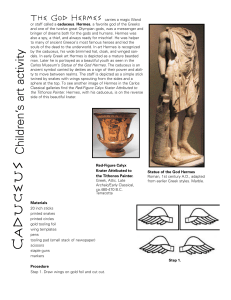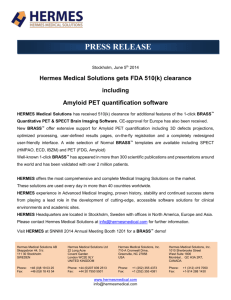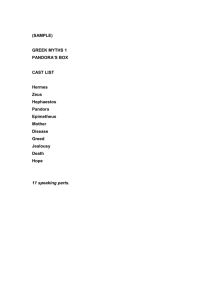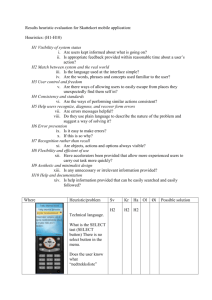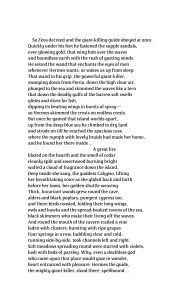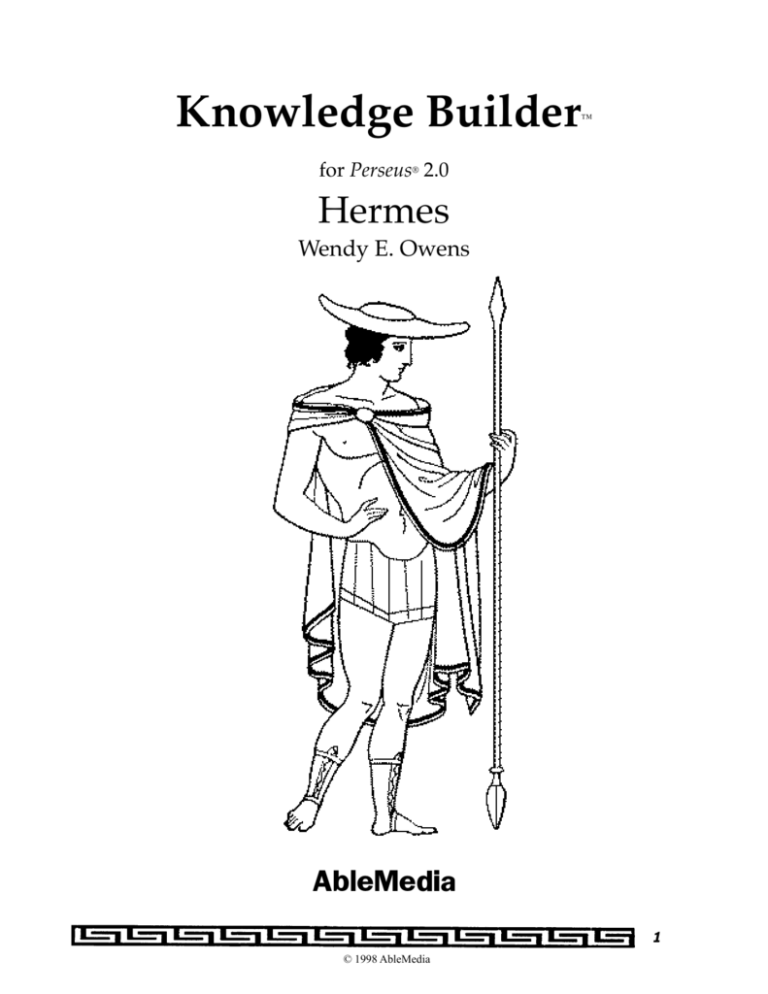
Knowledge Builder
™
for Perseus® 2.0
Hermes
Wendy E. Owens
AbleMedia
1
© 1998 AbleMedia
Knowledge Builder
™
for Perseus® 2.0
Hermes
Wendy E. Owens
Copyright © 1998 AbleMedia
50 Clark Street, Medford, MA 02155-4474
All Rights Reserved
No part of this assignment may be reproduced by any mechanical, photographic, or electronic process, or
in the form of a phonographic recording, nor may it be stored in a retrieval system, transmitted, or
otherwise copied for public or private use, without the written permission from the publisher.
Printed in the United States of America.
Perseus is a registered trademark of the President and Fellow of Harvard College and
the Corporation for Public Broadcasting.
All copyrights are the property of their respective owners.
2
© 1998 AbleMedia
Knowledge Builder
™
for Perseus® 2.0
Hermes
Wendy E. Owens
About Knowledge Builders
•
Knowledge Builders are step-by-step instructions for expanding your knowledge of
the Perseus software and the ancient Greek world. Each Knowledge Builder addresses a particular topic related to the ancient Greek world. Knowledge Builders
provide students and teachers with start up information on a topic and directions for
finding the information available on that topic in Perseus.
• Knowledge Builders assume that you have completed the assignments of the Quick
Start System™ or that you have a working knowledge of Perseus and a Macintosh.
• Knowledge Builders give you a start on investigations of various topics related to
the main Knowledge Builder topic(s). Look for “Possible Projects” in the text of the
Knowledge Builder for ideas on how to turn ideas and investigative processes into a
project.
• Each Knowledge Builder provides you with a list of Further Reference in Perseus for
topics related to the main topic of the Knowledge Builder.
• Each Knowledge Builder provides you with an annotated bibliography of works
relating to the main topics associated with the title of the Knowledge Builder.
• Knowledge Builders make an effort to use Vase, Coin, Site, Sculpture and Architecture Catalog cards in which Universal Images can be found. By using these Catalog
cards, Concise version users can see large images and will learn which Catalog cards
use Universal Images.
• Knowledge Builders get you started using Perseus and get you thinking with a large
academic database. The methods for investigation used in Knowledge Builders are
suggestions and other methods may be applied. You must come up with your own
methods for making the most efficient use of Perseus.
3
© 1998 AbleMedia
Hermes
1. Begin this Knowledge Builder™ from the Perseus Gateway.
Epithets
The names of gods and goddesses are often accompanied by a finite number of traditional epithets that describe the personality or associations of the divinity. You can form
a better understanding of how the Greeks and other cultures viewed the nature of their
gods and goddesses from the list of epithets associated with a god or goddess.
2. Click once on the “Tools & Reference” icon on the Gateway.
3. Under the bold “Philological Tools” heading, click once on “English-Greek Word
List.”
4. Your screen should look like the one below.
4
© 1998 AbleMedia
5. Set the cursor on the line next to the “Look up” command button.
6. Type in the word “helper.”
7. Choose “This word only” from the pop-up menu button next to “as.”
8. Click once on the “Look Up” command button.
9. Highlight the Greek word as seen below.
Remember, give Perseus something to do and
then give it a command.
10. Choose “Greek English Lexicon” from the “Related Tools” pop-up menu button.
5
© 1998 AbleMedia
11. Read the definition for this word.
Associated Rituals
An important part of the nature of a god or goddess may be discerned from the rituals
performed for the favor of that god or goddess. You will now look at the rituals performed in association with Hermes. You will also want to discover where the rituals are
performed, who performs the rituals and whether the societies that include this ritual in
their religious practices worship only Hermes or Hermes along with other gods and
goddesses. Pay attention to what a suppliant asks for in return for sacrificing to the
god.
Below are some textual examples of ritual sacrifices to Hermes and rituals that are part
of the festivals for Hermes.
Hermes of the Market, with his oracular powers, will whisper the answer to a person’s
questions if they leave a “copper” on the altar of the image of Hermes.
12. Choose “Primary Text” from the Links menu.
13. Click once on “Pausanias” in the list of authors in the left column.
6
© 1998 AbleMedia
14. Click once on “Book 7” from the list of text in the right column.
15. Your screen should look like the one below.
16. Click once on the “Go to” command button.
17. Type “7.22.2” on the line.
18. Click once on the “Go” command button.
19. Your screen should look like the one below.
7
© 1998 AbleMedia
20. Read from section 22.2 to section 22.3 to learn about the oracle of Hermes.
**Note: Homer refers to Hermes as the “ear giver” to men in the Iliad 24.334.
The people of Pheneus worshipped Hermes and celebrated the games called Hermaea
in his honor.
21. Choose “Go to Index” from the Text menu.
22. Click once on “Pausanias” in the list of authors in the left column.
23. Click once on “Book 8” from the list of text in the right column.
24. You should now be at 8.1.1.
25. Click once on the “Go to” command button.
26. Type “8.14.10” on the line.
27. Click once on the “Go” command button.
8
© 1998 AbleMedia
28. Read section 8.14.10.
There are sanctuaries of Hermes Ram-bearer and of Hermes Champion. To see an
example of how the ram was carried in the ritual see the sculpture, “Athens, Acropolis
624.”
29. Click once on the “Go to” command button.
30. Type “9.22.1” on the line.
31. Click once on the “Go” command button.
32. Read from section 9.22.1 to section 9.22.2.
Hermes started the ritual sacrificing of meat to the gods. In this passage from the
Homeric Hymn to Hermes, the author tells the story of the sacrifice.
33. Choose “Lookup” from the Links menu. Lookup is at the top of the Links list.
34. Type “HH 4.94” into the Lookup box.
9
© 1998 AbleMedia
35. Choose “Primary Text” from the Links menu.
36. Read from line 94 to line 133.
Family
As one of the twelve main gods, Hermes’ relatives and offspring appear in many main
stream and well-known myths. The Encyclopedia entry for Hermes tells of Hermes’
family, including his children by various mortals and goddesses.
37. Click once on the “Gateway” icon on your Navigator.
38. Click once on the “Tools & Reference” icon on the Gateway.
39. Under the bold “Encyclopedia” heading, click once on “Alphabetical Index.”
40. Click once on the letter “H” from the alphabet at the bottom of the card.
41. Scroll through the list of “H” words until you find “Hermes.”
10
© 1998 AbleMedia
42. Click once on the word “Hermes.”
43. Your screen should look like the one below.
44. Scroll to the middle of the card. Highlight the citation “Apollod. vol. 2.305” next to
the note “father of Pan by Penelope.”
45. Choose “Primary Text” from the Links menu.
46. Read section 7.38.
11
© 1998 AbleMedia
Hermes in Art
The depictions of a god or goddess by ancient Greek artist are normally consistent and
drawn from the mythology surrounding the god or goddess. In the case of Hermes,
artists have depicted him as an older man with a beard and as one of the youngest
gods. You should investigate the aging of Hermes and whether this aging takes place
over archaeological periods or if it is simply a random occurrence. Below are selected
vases and coins on which Hermes appears.
47. Choose “Browser,” the last Link on the Links menu.
48. Your screen should look like the one below.
49. Click once inside the radial button next to “Coins.”
50. Choose “Keywords” from the first pop-up menu button.
12
© 1998 AbleMedia
51. Choose “Divinities” from the second pop-up menu button.
52. From the list of “Divinities,” choose “Hermes.”
53. From the list of coins, click once on “Dewing 1269.”
54. You will now be at the Coin Catalog card for “Dewing 1269.”
55. Look at the obverse for this coin.
56. Click once on the “Go Back” arrow on your Navigator.
13
© 1998 AbleMedia
57. From the list of coins, click once on “Dewing 1273.”
58. You will now be at the Coin Catalog card for “Dewing 1273.”
59. Look at the obverse for this coin.
60. Click once on the “Go Back” arrow on your Navigator.
61. Click once inside the radial button next to “Vases.”
62. Choose “Divinities” from the second pop-up menu button.
63. From the list of “Divinities,” choose “Hermes.”
64. From the list of vases, click once on “Baltimore, Hopkins AIA B9.”
65. You will now be at the Vase Catalog card for “Baltimore, Hopkins AIA B9.”
14
© 1998 AbleMedia
66. Look at the image “Bearded man wearing petasos and youth play with spinning
top.” Could this be Hermes playing with a top?
Remember, close each image after you
have finished looking at it.
67. Click once on the “Go Back” arrow on your Navigator. You should be a the
Browser.
On the next two vases, Hermes is portrayed as a messenger and holds his messenger
wand. Look at the differences between the two Hermes’s. Notice the archaeological
periods for each vase.
68. From the list of vases, click once on “Harvard 1960.347.”
69. You will now be at the Vase Catalog card for “Harvard 1960.347.”
70. Look at the image “Seated Hermes with caduceus.”
15
© 1998 AbleMedia
71. Click once on the “Go Back” arrow on your Navigator.
72. From the list of vases, click once on “Harvard 1977.216.2244.”
73. You will now be at the Vase Catalog card for “Harvard 1977.216.2244.”
74. Look at the image “Side A: Hermes.”
Associated Items and Beings
A god or goddess alone is inadequately defined since the people, beings, animals and
things associate with a god or goddess say a lot about them. Through visual aids and
texts, you can learn about the whole god or goddess by the items, people, beings,
animals and things that accompany them or that are used in their exploits. Below are
vases and texts that depict one of the things associated with Hermes, his wand or
caduceus.
75. Choose “Primary Text” from the Links menu.
76. Click once on “Apollodorus” in the list of authors in the left column.
77. Click once on “Book 3” from the list of text in the right column.
78. You should now be at line one of Book 3.
79. Click once on the “Go to” command button.
80. Type “3.10.2” on the line.
16
© 1998 AbleMedia
81. Click once on the “Go” command button.
82. Your screen should look like the one below.
83. Read section 3.10.2 to learn who gave Hermes his wand.
84. Choose “Lookup” from the Links menu. Lookup is at the top of the Links list.
85. Type “Hom. Od. 24.1” into the Lookup box.
86. Choose “Primary Text” from the Links menu.
87. Begin reading this text on line 1.
So what did this caduceus look like?
88. From the Links menu, choose “Vases” by highlighting the word.
17
© 1998 AbleMedia
89. You should now be at the Vase Index.
A list of all the vase collections in Perseus will appear on the left side of the card.
90. From this list, choose “British Museum, London.”
91. A list of vases will appear in the right column. Choose “London B 226” from the
list.
92. Your screen should look like the one below.
93. Look at a view for this vase by clicking once on “Side B: Herakles and Pholos.” The
caduceus is hard to see but you can just make it out.
18
© 1998 AbleMedia
94. Click once on the “Go Back” arrow on your Navigator.
95. From the Collections list, choose “Cambridge, Harvard University Art Museum.”
96. A list of vases will appear in the right column. Choose “Harvard 1960.347” from the
list.
97. Look at a view for this vase by clicking once on the words “Main panel: Seated
Hermes with caduceus, caduceus.”
Hermes the Guide
Besides being the appointed herald to the gods, Hermes was also a guide of men,
women, gods and spirits. Hermes conducted the souls of the dead to the Underworld
as well as leading goddesses to the tops of mountains. You will investigate Hermes’
role in Greek mythology as a guide. Pay close attention to the idea of Hermes as a “gobetween,” who acts as a middle-man between gods and men.
In the next two passages, from separate authors, Hermes guides souls to Hades.
98. Choose “Primary Text” from the Links menu.
99. Click once on “Sophocles” in the list of authors in the left column.
19
© 1998 AbleMedia
100. Click once on “Ajax” from the list of text in the right column.
101. Click once on the “Go to” command button.
102. Type “833” on the line.
103. Click once on the “Go” command button.
104. You should now be at line 833 of Ajax.
105. Read line 833.
106. Choose “Go to Index” from the Text menu.
In this passage, Hermes guides Hera, Athena and Aphrodite to Mt. Ida. On Mt. Ida,
Paris will judge which goddess is the most beautiful. The goddess he selects will give
him something in return.
107. Click once on “Apollodorus” in the list of authors in the left column.
108. Click once on “Epitome” from the list of text in the right column.
109. You should be at section 1.1 of the Epitome.
110. Click once on the “Go to” command button.
111. Type “E.3.1” on the line.
112. Click once on the “Go” command button.
20
© 1998 AbleMedia
113. Read section 3.1 to section 3.3.
Hermes’ Personality
Unlike Ares the war god, Hermes tends towards the lighter side of the human personality. Look at following primary text entries for Hermes that deal with his personality. The
anthropomorphic version of Hermes offers insight into his role in the great scheme of
Greek life.
The Helper
114. From the Links menu, choose “Sculpture” by highlighting the word.
115. Move your Mouse arrow onto the “Index” pop-up menu button in upper right
corner of the card.
116. From the Index menu, choose “Type.”
A list of all sculpture types in Perseus will now appear on the left side of the card.
117. From this list, choose “Architectural-pediment.”
118. A list of sculpture will appear in the right column. Choose “Parthenon, West
Pediment” from the list.
21
© 1998 AbleMedia
119. Your screen should look like the one below.
120. Click once on the “Description” command button and read how Hermes came to
the aid of Athena.
121. Click once on the “Summary” command button.
122. Look at the image “West pediment: Figure H (Hermes-L) and Figure L (AthenaR).”
Hermes acts as guide to Orestes as a favor to his brother, Apollo. Apollo is the brother
whom Hermes tricked as a youngster.
123. Choose “Primary Text” from the Links menu.
124. Click once on “Aeschylus” in the list of authors in the left column.
125. Click once on “Eumenides” from the list of text in the right column.
22
© 1998 AbleMedia
126. Click once on the “Go to” command button.
127. Type “87” on the line.
128. Click once on the “Go” command button.
129. Read from line 87 to line 93.
The Crafty Hermes
A Homeric Hymn tells the story of Hermes, as a baby, stealing Apollo’s cattle. Hermes
tries to out smart Apollo and Zeus and to get away with the theft.
130. Choose “Primary Text” from the Links menu.
131. Click once on “Homeric Hymns” in the list of authors in the left column.
132. Click once on “Hymn 4: To Hermes” from the list of text in the right column.
133. Click once on the “Go to” command button.
134. Type “4.68” on the line.
135. Click once on the “Go” command button.
136. Your screen should look like the one below.
137. Read lines 68-104.
23
© 1998 AbleMedia
Homer combines the two sides of Hermes, calling him a helper but also “cunning beyond all others in his mind.”
138. Choose “Lookup” from the Links menu. Lookup is at the top of the Links list.
139. Type “Hom. Il. 20.34” into the Lookup box.
140. Choose “Primary Text” from the Links menu.
141. You should be at Book 20, line 34.
142. Read this passage beginning on line 34.
The Herms
The Herms, stone post bearing the head of Hermes and a large phallus, are associated
with the luck bringing aspect of the god. Use the information found in Perseus and in
other source materials to investigate the Herms and their religious significance. Below
you will look at Links in which information on the Herms appears.
143. Choose “Historical Overview” from the Links menu.
144. Your screen should look like the one below.
24
© 1998 AbleMedia
145. Scroll through the table of contents to “12.1.12 Launching the expedition to Sicily.”
146. Click once on “12.1.12 Launching the expedition to Sicily.”
147. Your screen should look like the one below.
148. Read this topic card.
149. Click once on the right “Next Card” arrow on your Navigator.
150. You should not be at the topic card “12.1.12.a The mutilation of Herms.”
25
© 1998 AbleMedia
151. Read this topic card.
Herodotus offers an explanation of where the idea for the Herms came from.
152. Choose “Lookup” from the Links menu. Lookup is at the top of the Links list.
153. Type “Hdt. 2.51.1” into the Lookup box.
154. Choose “Primary Text” from the Links menu.
155. Begin reading this text at section. 2.51.1.
This vase offers an excellent example of a Herm.
156. From the Links menu, choose “Vases” by highlighting the word.
157. From this list of collections, choose “Museum of Fine Arts, Boston.”
158. A list of vases will appear in the right column. Choose “Boston 10.185” from the
list.
26
© 1998 AbleMedia
159. Your screen should look like the one below.
160. Look at a view for this vase by clicking once on the words “Side B: drawing of Pan
pursuing goatherd (small).”
If you look closely at the reverse of this coin you can see a small herm in the mouth of
the goat.
161. Choose “Lookup” from the Links menu. Lookup is at the top of the Links list.
162. Type “Dewing 1269” into the Lookup box.
163. Choose “Coins” from the Links menu.
164. Your screen should look like the one below.
165. Look at the reverse for this coin.
27
© 1998 AbleMedia
You should also perform an English Index for “Herm” for a full list of Herm citations.
Hermes and Iris as Messengers
You should use the information below to investigate the role of Herms and Iris as messengers to the gods. Through a thorough examination of texts and art you can gain a
better idea of just what being a messenger to the gods entailed.
On the following vase, Hermes leads Athena, Aphrodite and Hera to be judged by Paris.
Images of the Messenger
166. Choose "Browser" from the Links menu.
167. From the list of “Divinities,” choose “Hermes.”
168. From the list of vases, click once on “Malibu 86.AE.52.”
169. You will now be at the Vase Catalog card for “Malibu 86.AE.52.”
170. Look at the image “Side B: Judgement of Paris.”
Below, Iris leads a procession of gods and holds wand like Hermes’.
171. Click once on the “Go Back” arrow on you Navigator.
172. From the list of “Divinities,” choose “Iris.”
173. From the list of vases, click once on “Florence 4209.”
174. You will now be at the Vase Catalog card for “Florence 4209.”
175. Look at the image “Main frieze, Dionysos, Hestia, Chariklo, Iris, Chiron (FR).”
28
© 1998 AbleMedia
Texts
Hesiod does not use Hermes’ name in this passage. Instead he refers to him as the
“Argus-Slayer, the swift messenger” sent by Zeus to take Pandora to Epimetheus.
176. Choose “Lookup” from the Links menu. Lookup is at the top of the Links list.
178. Type “Hes. WD 85” into the Lookup box.
179. Choose “Primary Text” from the Links menu.
180. Begin reading this text on line 85.
Zeus sends Iris with a very important message to the Trojans.
181. Choose “Primary Text” from the Links menu.
182. Click once on “Homer” in the list of authors in the left column.
183. Click once on “Iliad” from the list of text in the right column.
184. You should be at Book 1, line 1.
185. Click once on the “Go to” command button.
186. Type “2.787” on the line.
187. Click once on the “Go” command button.
189. Read this passage beginning on line 787.
29
© 1998 AbleMedia
Iris
Iris as female version of Hermes
Like Hermes, Iris was a messenger to the gods. Hesiod explains that Zeus used her as
a herald when the gods fought amongst themselves. Look at Iris as an independent
goddess and as the female version of Hermes.
1. Choose “Browser,” the last Link on the Links menu.
2. Click once inside the radial button next to “Sculpture.”
3. Choose “Keywords” from the first pop-up menu button.
4. Choose “Divinities” from the second pop-up menu button.
5. From the list of “Divinities,” choose “Iris.”
6. From the list of sculpture, click once on “Parthenon, West Pediment.”
7. You will now be at the Sculpture Catalog card for “Parthenon, West Pediment.”
30
© 1998 AbleMedia
8. Click once on the “Description” command button.
9. In the “See also” list at the bottom of the card, click once on “Parthenon WP. N.” This
will take you to a specific card for the statue of Iris.
10. Look at the image “West pediment: Figure N (‘Iris’), front view.”
11. Choose “Primary Text” from the Links menu.
12. Click once on “Hesiod” in the list of authors in the left column.
13. Click once on “Theogony” from the list of text in the right column.
14. Your screen should look like the one below.
15. Click once on the “Go to” command button.
16. Type “265” on the line.
31
© 1998 AbleMedia
17. Click once on the “Go” command button.
18. Read this passage beginning on line 265.
19. Click once on the “Go to” command button.
20. Type “780” on the line.
21. Click once on the “Go” command button.
22. Read this passage beginning on line 780.
Congratulations! You have completed this Knowledge Builder™. Review
any information with which you do not feel comfortable.
32
© 1998 AbleMedia
Further References
Below you will find a listing of Coins, Architecture, Vases, Primary Text, Encyclopedia
entries and Sites relating to the bolded topic. These lists are the results of English Index
searches for each of the bolded topics.
You can go to all these citations, except for Primary Text entries, without having to
perform an English Index search. Follow the directions below.
• Highlight “Lookup” under the Links menu at the top of the screen.
• Type a citation into the “Lookup” box and highlight the corresponding Link for that
citation, i.e. type “Harvard 1959.123” and highlight “Vases” under Links at the top of
the screen.
Hermes
Coins: Dewing 1269, Dewing 1273, Dewing 1274, Dewing 2240.
Vases: Baltimore, Hopkins AIA B9, Boston 00.330, Boston 10.185, Florence 4209,
Harvard 1960.347, Harvard 1977.216.2244, London 1971.11-1.1, London B226, London
B471, Malibu 86.AE.114, Malibu 86.AE.52, Malibu 86.AE.85, Munich 1426, Munich 2301,
Worcester 1966.63.
Primary Texts: Aeschylus, Agamemnon, Eumenides, Libibation Bearers, Prometheus Bound,
Persisans,Seven Against Thebes, Suppliant Maidens; Apollodorus, Library Books 1, 2, 3,
Epitome; Herodotus, History; Hesiod, Theogony, Works and Days; Homer, Iliad, Odyssey;
Pausanias, Guide to Greece: Books 1-10; Pindar, Isthmian Ode 1, Nemean Ode 10, Olympian
Odes 6, 8, Pythian Odes 2, 4, 9; Plutarch, Aristites, Cimon, Nicias, Theseus; Sophocles, Ajax,
Antigone, Electra, Oedipus at Colonus, Philoctetes,Trachiniae; Thucydides, History of the
Peloponnesian War.
Encyclopedia: Chelys-Lyra, encyclopedia,Lyre, encyclopedia,Macedonia.
Sculpture: Athens 1783, Athens, Agora I 7154, Athens, Agora S 2452, Athens, Agora S
2499, Parthenon WP.H, Parthenon West Pediment, Athens 1783, Parthenon WP.H.
Historical Overview: TRMartin 12.1.12, TRMartin 12.1.12.a.
Iris
Vases: Boston 63.473, Florence 4209, London 1971.11-1.1, Malibu 86.AE.77
Primary Texts: Apollodorus, Library Book 1; Hesiod, Theogony; Homer, Iliad; Guide to
Greece: Books 1, 2, 9.
Sculpture: Parthenon WP.N, Parthenon West Pediment.
33
© 1998 AbleMedia
For more free materials from
AbleMedia, visit the
Classics Technology Center
http://ablemedia.com/ctcweb
50 Clark Street • Medford • MA 02155-4474
(781) 396-7582 • FAX (781) 393-5643
e-mail: ctcweb@ablemedia.com
http://ablemedia.com/
34
© 1998 AbleMedia

